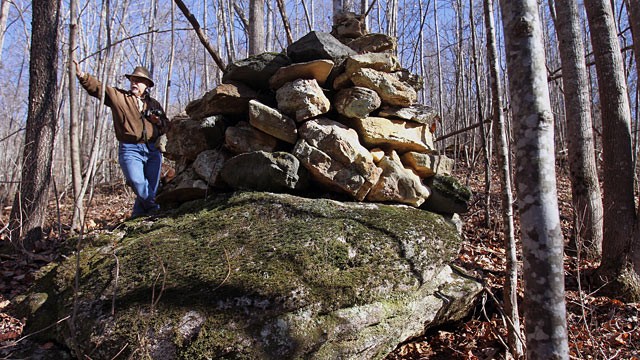Ruins in Georgia mountains show evidence of Maya connection
By Richard Thornton
In July of 2011, Waldrup furnished a copy of the 2000 Stratum Unlimited, LLC archaeological report to People of One Fire members. Those with experiences at Maya town sites instantly recognized that the Track Rock stone structures were identical in form to numerous agricultural terrace sites in Chiapas, Guatemala, Belize and Honduras. Johannes Loubser’s radiocarbon dates exactly matched the diaspora from the Maya lands and the sudden appearance of large towns with Mesoamerican characteristics in Georgia, Alabama and southeastern Tennessee. Track Rock Gap was the “missing link” that archaeologists and architects had been seeking since 1841.
Archaeologists have been looking for vestiges of “high” Maya civilization in the United States, when all along it was the commoners “who got the heck out of Dodge City” when wars, famines, droughts and almost non-stop volcanic eruptions became unbearable. The Itza Maya middle class and commoners became the elite of such towns as Waka (Ocmulgee National Monument) and Etalwa (Etowah Mounds) Just as happened in England after the Norman Invasion, the separate cultures of the commoners and nobility of the indigenous Southeast eventually blended into hybrid cultures that became our current Native American tribes.
This story quickly spread via Facebook, with people treating it as a revolutionary discovery. I disagreed. Thornton writes for Examiner.com, which means he's basically a blogger. His claims weren't supported by archaeologists and weren't presented in a peer-reviewed journal. This was nothing but an amateur's interpretation of some extremely skimpy evidence.
Some people defended Thornton because they'd heard of cultural connections between Mexico and the Southeast. Cultural connections are one thing, but a hitherto-unknown Maya citadel of stone in Georgia? That conclusion requires ironclad proof, not idle speculation.
Archaeologist says no
Unfortunately for Thornton, the archaeologist he cited soon shot him down:
Mayan Ruins in Georgia? Archeologist Objects, Debate Breaks Out Online
By Ned Potter
But could they possibly have left stone ruins in the mountains of North Georgia? Richard Thornton thinks so. He says he's an architect and urban planner by training, but has been hired to research the history of native people in and around Georgia since 2003. On Examiner.com, he wrote about an 1,100-year-old archeological site near Georgia's highest mountain, Brasstown Bald, that he said "is possibly the site of the fabled city of Yupaha, which Spanish explorer Hernando de Soto failed to find in 1540."
This might all be fairly arcane stuff, except that an archeologist he cited, Mark Williams of the University of Georgia, took exception. In the comments section after Thornton's piece, he wrote, "I am the archaeologist Mark Williams mentioned in this article. This is total and complete bunk. There is no evidence of Maya in Georgia. Move along now."
In fact, it resembles the "ancient astronaut" claims by Erich von Daniken and the like. The mound builders couldn't have built the stone structures themselves, Thornton implies, so they must've had outside help. The only difference is that the alleged help came from more sophisticated Indians, not from visiting Europeans, Asians, or Africans.
For more on lost civilizations, see Searching for El Dorado and Beck: Indian Mounds Are Egyptian.
Below: "A rock formation in the North Georgia woods." (Vino Wong/Atlanta Journal-Constitution/AP Photo)


No comments:
Post a Comment